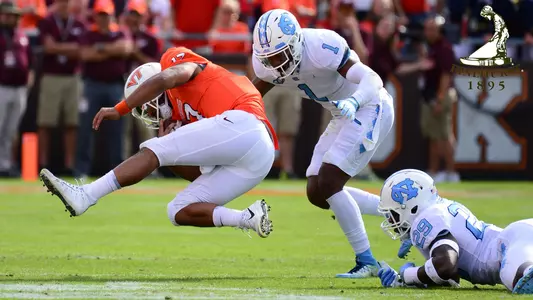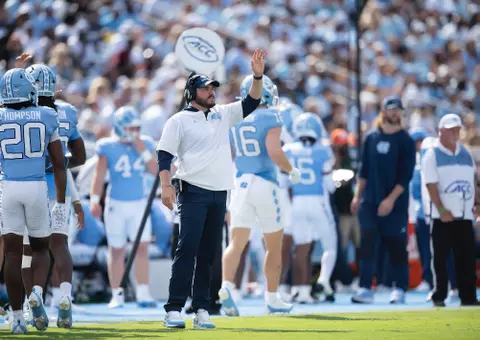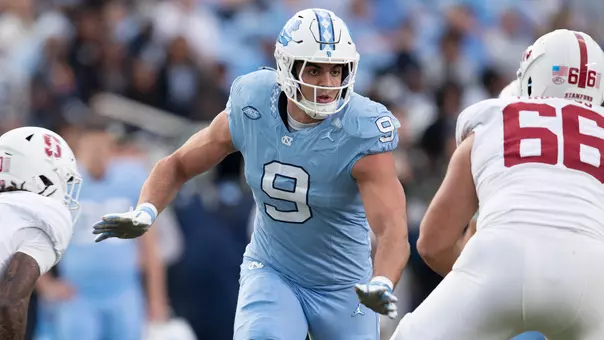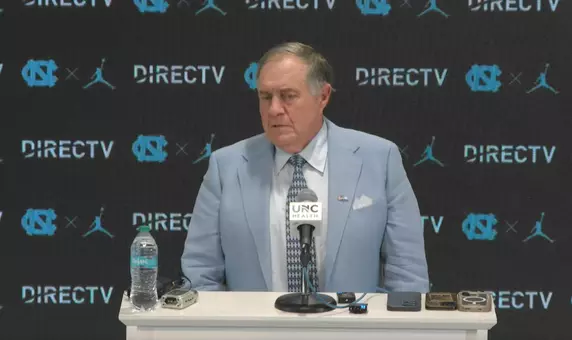University of North Carolina Athletics

Extra Points: Numbers
October 22, 2017 | Football, Featured Writers, Lee Pace
By Lee Pace
What has been will be again, what has been done will be done again; there is nothing new under the sun.
Ecclesiastes 1:9
In the wake of the Tar Heels' abysmal offensive performances against Georgia Tech and Virginia early in the 2009 season, Butch Davis was asked about coordinator John Shoop and if Davis still had confidence that Shoop was the proper engineer.
Davis quickly answered that he thought the criticism was unfair, that Shoop was a bright coach and that the offensive staff was working extremely hard to overcome the problems that had dogged it all year and particularly the last two weeks—performances that combined had netted only one touchdown and just over three yards a snap.
Davis then referenced Larry Coker, his offensive coordinator at Miami when they took a program ravaged by NCAA sanctions in 1995-96 into the upper echelon of college football in five years.
"They said Larry Coker had no clue what he was doing, he couldn't coach a lick as the offensive coordinator at Miami," Davis said. "Then unbelievably as Reggie Wayne got there and Kelvin Winslow Jr. got there and Andre Johnson got there and Clinton Portis got there and we started averaging 40 points, all of a sudden Larry Coker looked like a genius as the offensive coordinator. And all it was, was the growth in your program, in experience, in depth."
As it turned out eight years ago, the Tar Heels worked through some serious offensive line injury problems, got some stability and performance as the fall wore on and ran the table over one month in beating Virginia Tech, Miami, Duke and Boston College.
"There's no way to browbeat them and no way to threaten them and scream and rant and rave," Davis said in the thick of it all.
"You can't script this, you have to go through things like this," Davis noted at another point.
A version of that very theme had played itself out in Chapel Hill two decades earlier. Mack Brown was assailed during his 2-20 Carolina debut in 1988-89, but soon a team that featured Jason Stanicek, Natrone Means and Corey Holliday on offense and Austin Robbins, Dwight Holler and Thomas Smith on defense began winning games. While that was going on, Brown and staff ratcheted the talent level up another notch and, by the time the new line of newcomers had developed several years later in 1996-97, no one could move the ball on Greg Ellis, Brian Simmons and Dre Bly.
"This is a recruiting game," Brown said. "Forget Xs-and-Os. Personnel, that's the key."
It's important to keep that simple concept in mind digging through the wreckage of the Tar Heels' 59-7 clobbering Saturday at Virginia Tech. We have seen this movie before. It's rank and maddening. But these horror films eventually run their course with enough successes on the recruiting battlefront and enough time so they ripen into mature, tough, healthy, smart and committed players.
Already the 2017 season was destined to be a rebuilding year with the loss of 13 starters to graduation, two more to early NFL departures and one tailback and one defensive tackle who transferred out last winter.
Then an unprecedented barrage of injuries has sidelined for the year 10 players who have or potentially might have started and a handful more starters and key reserves that have missed one or more games. Carolina traveled to Blacksburg with only three defensive tackles and hoped it wouldn't have to play the fourth, freshman Xach Gill, whom the Tar Heels are hoping to redshirt.
The domino effect runs not only through the offense and defense but special teams as well. Carolina this year has given up a kickoff return for a touchdown (Old Dominion) and on Saturday yielded a blocked punt and a punt return for six. Carolina has only so many skill position and linebacker/tight end type bodies that populate the key kicking game units.
"With what has been happening with our numbers, special teams takes the biggest hit," Coach Larry Fedora said. "All of those guys play multiple positions along your four big special teams areas. You just keep working to do the best you can."
The Tar Heels averaged 2.7 yards per snap against a talented and deep Virginia Tech defense. Quarterback Chazz Surratt lost control of the ball twice in his throwing motion in the first half, once leading to a fumble that the Hokies recovered for a touchdown.
Then Brandon Harris had a pass tipped and plucked from the air for a pick-six. Neither quarterback had much time to throw as Tech sacked the Tar Heels six times.
Fedora and the Tar Heels are experiencing a level of offensive ineptitude that's difficult to fathom after enjoying five years that have produced an average of 453 yards and 36 points a game. Of 129 teams in the NCAA Football Bowl Subdivision statistical rankings, the Tar Heels are No. 126 in third-down conversions, 101 in completion percentage, 114 in most passes had intercepted, 113 total offense and 107 scoring offense.
For perspective, consider that the 2015 team that ripped off 11 straight wins and collected the ACC Coastal Division title was ninth in third-down conversions, No. 20 in completion percentage, No. 18 in total offense and No. 9 in scoring offense.
After the Tar Heels banished Miami 59-21 to clinch at least a tie for the conference title that year, Fedora was asked if that was the most talented team he'd ever coached.
"From top to bottom? This is a pretty talented team," he said. "It's really talented. In a lot of spots, we've got some really good players. And again, that's because of the staff, and the job that they've done recruiting."
In the aftermath of Saturday's loss in Blacksburg, Fedora was asked a version of the same question, only from a perspective 180 degrees opposite.
"Do you feel like you have enough talent right now to compete?" was the question.
"Yeah, we've got enough people," Fedora said. "We're going to put 11 out there, and those 11 are going to give you everything they've got."
Fedora has been resolute in not using injuries or the recruiting overhang of the recently resolved and long-running off-the-field imbroglio as an excuse for the overall dip in roster depth and quality. Make no mistake: Fedora will get the offense back to its 2012-16 standards. That's his bread-and-butter and what he's excelled at every step along his coaching evolution.
And the Tar Heel defense, the soft spot in the program in the past, is showing progress and is developing across the board. The last month in the first half of every game, coordinator John Papuchis's unit has shown some aggression, some big-play ability from underclassmen like Tomon Fox, Jason Strowbridge and K.J. Sails and has done a credible job turning red-zone threats into field-goal tries. But week after week, a thin roster caves when it has to play so long with the offense prone to three-and-out possessions.
"The defense hung in pretty well in the first half," Fedora said. "I saw them continue to fight."
That's all Fedora and the Tar Heels can continue to do the last month of the season. Meanwhile, the doctors will patch up some players, the strength staff will bulk up the others and the coaches will sign a batch more. It always gets back to a recruiting and development game. There's nothing new about that.
Lee Pace is in his 28th year covering Tar Heel football through "Extra Points" and 14th as the sideline reporter for the Tar Heel Sports Network. His book, "Football in a Forest," is available in bookstores across North Carolina and online at www.johnnytshirt.com. Email him at leepace7@gmail.com and follow him on Twitter @LeePaceTweet.
What has been will be again, what has been done will be done again; there is nothing new under the sun.
Ecclesiastes 1:9
In the wake of the Tar Heels' abysmal offensive performances against Georgia Tech and Virginia early in the 2009 season, Butch Davis was asked about coordinator John Shoop and if Davis still had confidence that Shoop was the proper engineer.
Davis quickly answered that he thought the criticism was unfair, that Shoop was a bright coach and that the offensive staff was working extremely hard to overcome the problems that had dogged it all year and particularly the last two weeks—performances that combined had netted only one touchdown and just over three yards a snap.
Davis then referenced Larry Coker, his offensive coordinator at Miami when they took a program ravaged by NCAA sanctions in 1995-96 into the upper echelon of college football in five years.
"They said Larry Coker had no clue what he was doing, he couldn't coach a lick as the offensive coordinator at Miami," Davis said. "Then unbelievably as Reggie Wayne got there and Kelvin Winslow Jr. got there and Andre Johnson got there and Clinton Portis got there and we started averaging 40 points, all of a sudden Larry Coker looked like a genius as the offensive coordinator. And all it was, was the growth in your program, in experience, in depth."
As it turned out eight years ago, the Tar Heels worked through some serious offensive line injury problems, got some stability and performance as the fall wore on and ran the table over one month in beating Virginia Tech, Miami, Duke and Boston College.
"There's no way to browbeat them and no way to threaten them and scream and rant and rave," Davis said in the thick of it all.
"You can't script this, you have to go through things like this," Davis noted at another point.
A version of that very theme had played itself out in Chapel Hill two decades earlier. Mack Brown was assailed during his 2-20 Carolina debut in 1988-89, but soon a team that featured Jason Stanicek, Natrone Means and Corey Holliday on offense and Austin Robbins, Dwight Holler and Thomas Smith on defense began winning games. While that was going on, Brown and staff ratcheted the talent level up another notch and, by the time the new line of newcomers had developed several years later in 1996-97, no one could move the ball on Greg Ellis, Brian Simmons and Dre Bly.
"This is a recruiting game," Brown said. "Forget Xs-and-Os. Personnel, that's the key."
It's important to keep that simple concept in mind digging through the wreckage of the Tar Heels' 59-7 clobbering Saturday at Virginia Tech. We have seen this movie before. It's rank and maddening. But these horror films eventually run their course with enough successes on the recruiting battlefront and enough time so they ripen into mature, tough, healthy, smart and committed players.
Already the 2017 season was destined to be a rebuilding year with the loss of 13 starters to graduation, two more to early NFL departures and one tailback and one defensive tackle who transferred out last winter.
Then an unprecedented barrage of injuries has sidelined for the year 10 players who have or potentially might have started and a handful more starters and key reserves that have missed one or more games. Carolina traveled to Blacksburg with only three defensive tackles and hoped it wouldn't have to play the fourth, freshman Xach Gill, whom the Tar Heels are hoping to redshirt.
The domino effect runs not only through the offense and defense but special teams as well. Carolina this year has given up a kickoff return for a touchdown (Old Dominion) and on Saturday yielded a blocked punt and a punt return for six. Carolina has only so many skill position and linebacker/tight end type bodies that populate the key kicking game units.
"With what has been happening with our numbers, special teams takes the biggest hit," Coach Larry Fedora said. "All of those guys play multiple positions along your four big special teams areas. You just keep working to do the best you can."
The Tar Heels averaged 2.7 yards per snap against a talented and deep Virginia Tech defense. Quarterback Chazz Surratt lost control of the ball twice in his throwing motion in the first half, once leading to a fumble that the Hokies recovered for a touchdown.
Then Brandon Harris had a pass tipped and plucked from the air for a pick-six. Neither quarterback had much time to throw as Tech sacked the Tar Heels six times.
Fedora and the Tar Heels are experiencing a level of offensive ineptitude that's difficult to fathom after enjoying five years that have produced an average of 453 yards and 36 points a game. Of 129 teams in the NCAA Football Bowl Subdivision statistical rankings, the Tar Heels are No. 126 in third-down conversions, 101 in completion percentage, 114 in most passes had intercepted, 113 total offense and 107 scoring offense.
For perspective, consider that the 2015 team that ripped off 11 straight wins and collected the ACC Coastal Division title was ninth in third-down conversions, No. 20 in completion percentage, No. 18 in total offense and No. 9 in scoring offense.
After the Tar Heels banished Miami 59-21 to clinch at least a tie for the conference title that year, Fedora was asked if that was the most talented team he'd ever coached.
"From top to bottom? This is a pretty talented team," he said. "It's really talented. In a lot of spots, we've got some really good players. And again, that's because of the staff, and the job that they've done recruiting."
In the aftermath of Saturday's loss in Blacksburg, Fedora was asked a version of the same question, only from a perspective 180 degrees opposite.
"Do you feel like you have enough talent right now to compete?" was the question.
"Yeah, we've got enough people," Fedora said. "We're going to put 11 out there, and those 11 are going to give you everything they've got."
Fedora has been resolute in not using injuries or the recruiting overhang of the recently resolved and long-running off-the-field imbroglio as an excuse for the overall dip in roster depth and quality. Make no mistake: Fedora will get the offense back to its 2012-16 standards. That's his bread-and-butter and what he's excelled at every step along his coaching evolution.
And the Tar Heel defense, the soft spot in the program in the past, is showing progress and is developing across the board. The last month in the first half of every game, coordinator John Papuchis's unit has shown some aggression, some big-play ability from underclassmen like Tomon Fox, Jason Strowbridge and K.J. Sails and has done a credible job turning red-zone threats into field-goal tries. But week after week, a thin roster caves when it has to play so long with the offense prone to three-and-out possessions.
"The defense hung in pretty well in the first half," Fedora said. "I saw them continue to fight."
That's all Fedora and the Tar Heels can continue to do the last month of the season. Meanwhile, the doctors will patch up some players, the strength staff will bulk up the others and the coaches will sign a batch more. It always gets back to a recruiting and development game. There's nothing new about that.
Lee Pace is in his 28th year covering Tar Heel football through "Extra Points" and 14th as the sideline reporter for the Tar Heel Sports Network. His book, "Football in a Forest," is available in bookstores across North Carolina and online at www.johnnytshirt.com. Email him at leepace7@gmail.com and follow him on Twitter @LeePaceTweet.
Players Mentioned
MBB: Hubert Davis Post-ECU Press Conference
Tuesday, December 23
Carolina Insider: Rapid Reactions pres. by Modelo – Men’s Basketball vs. ECU – December 22, 2025
Tuesday, December 23
UNC Men's Basketball: Tar Heels Breeze Past ECU, 99-51
Tuesday, December 23
Carolina Stories: Inspiring Through Team IMPACT
Monday, December 22




















